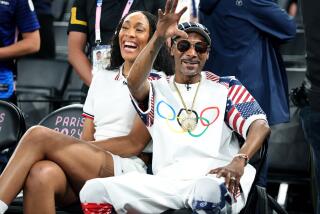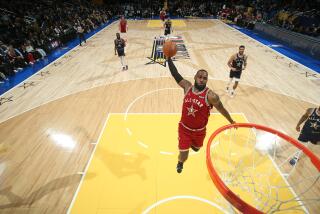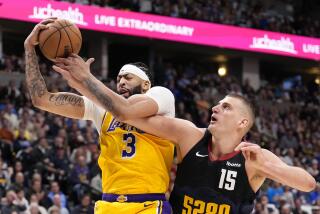NBA works to feed world’s audiences
In the Orlando Magic locker room Thursday there was French media interviewing Mickael Pietrus of France in French. There was a reporter from Turkey talking to Turkey’s Hedo Turkoglu in Turkish, a Polish reporter asking questions in Polish of Marcin Gortat who is, of course, from Poland.
In the main interview area an announcement was made that as soon as the Lakers’ Pau Gasol fulfilled his English obligations he would be available in a hallway for Spanish-speaking media.
And in the large media work room where reporters on tight deadlines were at the same time writing and trying to watch the game on television a Spanish cameraman and reporter did a stand up piece while standing in front of the TV, a bit of rudeness that caused a couple of writers to agree that TV guys always think they’ve got the right of way.
Even NBA Commissioner David Stern, in his state of the game question-and-answer, was asked international questions such as: “I just wanted to ask how you see Asia, and, in particular, India, as a market . . . how are you looking at the growth of the NBA in India in particular?”
Stern called India an “important growth opportunity” for the NBA and mentioned helpfully that, “We had the Bollywood representatives at a Lakers game.” More seriously Stern said the NBA was planning a new NBA website for India in both English and Hindi.
In July a version of “Where Amazing Happens,” a behind-the-scenes look at the NBA Finals, will air in India. This year, for the first time the championship games are available to a Middle Eastern audience in Arabic on Al Jazeera and for the first time since 2005 are on a free television channel in Mexico.
As newspapers in the United States lose staff and fewer media members travel to big events such as the NBA Finals, over 250 international journalists have already arrived in Los Angeles and more are expected in Orlando, according to the NBA.
Tim Kane is running an elaborate operation in a separate trailer at Staples Center that provides TV feeds to 215 countries in 42 languages. And in many of those countries there are no commercials sold, so while we’re watching ads foreign viewers get extra shots of Jack Nicholson or scenes from Los Angeles.
Matt Brabants, vice president for international television for the NBA, said the major growth in the last five years has come in Asia. “China of course,” Brabants said, “but all of Southeast Asia, Singapore, India, those are huge growth markets.
“Not only are those markets wanting game coverage,” Brabants said, “but they want more out-of-game content, more than just a nightly game. Turkey is a great example. With Hedo Turkoglu doing so well in Orlando, Turkish television wants more Magic games but also more features on the NBA.”
George Eddy, a native of Orlando whose mother is French, is covering his 23rd NBA finals for a French cable channel, Canal+, sort of the French version of HBO, a paid channel that offers the NBA Finals live in France.
“When I started 23 years ago,” Eddy said, “I was almost the only guy not from the United States. Now you hear almost as many foreign languages as English.”
Kane, a tall, quiet Princeton graduate who speaks, he said ruefully, “only English,” directs the international feed from that NBA trailer. “If you think about it,” Kane said, “it could be a little intimidating. We’re packaging our game for a world of people who have different sporting interests. And every year more countries want the feed.”
But Kane didn’t have long to speak. Stern was about to do his news conference. The world was waiting.
--


